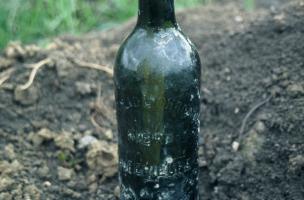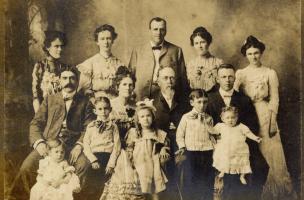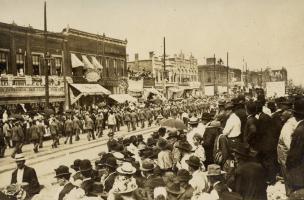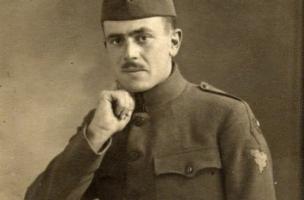Search
You are here
Message in a bottle
Following prescription from the Regional Archaeology Service, a team of archaeologists from the Institut national de recherches archéologiques preventives - INRAP - excavated a large Merovingian (6th-7th centuries) settlement at the "Noires terres" locality (Messein, in Meurthe-et-Moselle).
Chronicle of site
Post date
29 January 2008
Last modified
15 January 2018
In the southern part of the site, a series of modern early 20th century pits was discovered. In one of them, pit number 1221, was found a bottle.
This glass bottle of Champigneulles, a regional beer, was still equipped with its mechanical closing system with a porcelain cap. Inside tightly rolled up, was a letter from Oklahoma City, dated July 15, 1918. This letter was addressed to Sergeant Morres Vickers Liepman, Battery D 130th Field a, 35th Division American expeditionary force.
This glass bottle of Champigneulles, a regional beer, was still equipped with its mechanical closing system with a porcelain cap. Inside tightly rolled up, was a letter from Oklahoma City, dated July 15, 1918. This letter was addressed to Sergeant Morres Vickers Liepman, Battery D 130th Field a, 35th Division American expeditionary force.
My dear Morres...
Over four pages, "Aunt Pete" wrote to her nephew, on the frontline with news from back home. She spoke of a mobilized America, of the difficulty of finding domestic help, and of the massive draft of black Americans. She regretted the effects of the scissors of censorship and gave here nephew advice on this subject.
Morres V. Liepman, who studied in Pittsburgh (Kansas), was enlisted on July 25, 1917. Reaching Le Havre in June 1918, he participated in the battles of Argonne, Saint-Mihiel, Verdun and Vosges. In the autumn of 1918, his unit was stationed in the Haye Forest sector (near Nancy) not far from the "Noires terres" where his letter was found.
Morres V. Liepman returned back to the States in 1919 and was demobilized on September 3 at Camp Dodge (Iowa).
Morres V. Liepman, who studied in Pittsburgh (Kansas), was enlisted on July 25, 1917. Reaching Le Havre in June 1918, he participated in the battles of Argonne, Saint-Mihiel, Verdun and Vosges. In the autumn of 1918, his unit was stationed in the Haye Forest sector (near Nancy) not far from the "Noires terres" where his letter was found.
Morres V. Liepman returned back to the States in 1919 and was demobilized on September 3 at Camp Dodge (Iowa).
Restoration of the letter
Aunt Pete's letter was written in blue ink (primarily composed of aniline) on four single side sheets of mechanical pulp paper set in an envelope. The letterhead paper is that of Robert M. Scott, a hardware drugstore owner in Oklahoma City. A small amount of water at the bottom of the bottle slightly damaged the edges of the envelope and the pages with which it was in direct contact. The envelope was torn when it was first opened in 1918. Restoration of this manuscript was undertaken by the graphic document, binding and gilding workshop of the conservation department of the Archives Nationales.
Archaeology of the Great War
For the past fifteen years, archaeologists in eastern and northern France have often encountered remains from the Great War. First considered as contaminating factors in archaeological excavations, or even as a potential source of danger (ancient ammunition), these remains have little by little become the subject of archaeological research in their own right. Archaeologists have been particularly interested in funerary archaeology, with meticulous excavations of the grave of Alain Fournier at Saint-Rémy-la-Calonne, the ditch of the 10th Lincolnshire at Arras…
In 2003, a team of Inrap archaeologists returned the bodily remains and personal belongings of two American soldiers killed in action at Soisson in 1918. One of them, Francis Luppo, was identified through DNA analysis and buried in the Arlington military cemetery on September 25, 2006.
Sergt. Morres Vickers Liepman
Battery D 130th Field A(rtillery Regiment)
35th Division
American Expeditionary (Forces)
July 15' 18
My Dear Morres,
Well I guess you didn't know you were sending me a birthday letter you wrote me June the 8th and I got it July 8th. Say don't ever again write on both sides of the paper for your letter was all cut up – you see where they cut out what they didn't want poor me to know, they cut out the other side too.
I got a postal picture of Jule today. He is at Camp S[?]. Philadelphia – expects to sail any time. You have surely heard from some of us by now. We are wondering if you have been in any of the war yet. We see a dispatch once in a while about some of Camp Doniphan boys being in the firing line. They claim that they have a million men accross now. So it must begin to look like America over there.
Its all most impossible to get help of any kind and those you do get are likely to be called any time. There is a big bunch of darkeys going tomorrow night. They had a big parade today and are going to have a big dance tomorrow at the colored park : we lost our porter.
I wish you could hear Louise talk French. Her teacher says she is the best in the class. Robert is still in summer school, but gets out Aug. 1st. He reads all the papers and magazines he can get about the war, and every once in a while he breaks out with "I wish I could ask Morres so and so he would know", and he can't understand why they cut out the names off the postal cards.
It is so hot here that you could cook eggs in the sand, and the tires are all but off the old Jack Rabbit we ride untill about eleven every night getting cooled off.
Gee Morres I wish I could visit you now. It sure would be some trip. Robert says he would like to see it all, but he don't think he would like to get in the war. You should see my socks I knit, they are some gay ones. I had Rob try them on and his foot was lost. He only wears a six shoe and I make all the socks eleven or twelve inches long.
We see as many soldiers as ever. Fort Sill is full of them. Bess said you got Captain Brady back. What is he now, Major ?
Well write me when you can. With heaps of love from the family and best wishes.
From Aunt Pete
Mama says she has written you several letters.
In 2003, a team of Inrap archaeologists returned the bodily remains and personal belongings of two American soldiers killed in action at Soisson in 1918. One of them, Francis Luppo, was identified through DNA analysis and buried in the Arlington military cemetery on September 25, 2006.
The letter
Sergt. Morres Vickers Liepman Battery D 130th Field A(rtillery Regiment)
35th Division
American Expeditionary (Forces)
July 15' 18
My Dear Morres,
Well I guess you didn't know you were sending me a birthday letter you wrote me June the 8th and I got it July 8th. Say don't ever again write on both sides of the paper for your letter was all cut up – you see where they cut out what they didn't want poor me to know, they cut out the other side too.
I got a postal picture of Jule today. He is at Camp S[?]. Philadelphia – expects to sail any time. You have surely heard from some of us by now. We are wondering if you have been in any of the war yet. We see a dispatch once in a while about some of Camp Doniphan boys being in the firing line. They claim that they have a million men accross now. So it must begin to look like America over there.
Its all most impossible to get help of any kind and those you do get are likely to be called any time. There is a big bunch of darkeys going tomorrow night. They had a big parade today and are going to have a big dance tomorrow at the colored park : we lost our porter.
I wish you could hear Louise talk French. Her teacher says she is the best in the class. Robert is still in summer school, but gets out Aug. 1st. He reads all the papers and magazines he can get about the war, and every once in a while he breaks out with "I wish I could ask Morres so and so he would know", and he can't understand why they cut out the names off the postal cards.
It is so hot here that you could cook eggs in the sand, and the tires are all but off the old Jack Rabbit we ride untill about eleven every night getting cooled off.
Gee Morres I wish I could visit you now. It sure would be some trip. Robert says he would like to see it all, but he don't think he would like to get in the war. You should see my socks I knit, they are some gay ones. I had Rob try them on and his foot was lost. He only wears a six shoe and I make all the socks eleven or twelve inches long.
We see as many soldiers as ever. Fort Sill is full of them. Bess said you got Captain Brady back. What is he now, Major ?
Well write me when you can. With heaps of love from the family and best wishes.
From Aunt Pete
Mama says she has written you several letters.
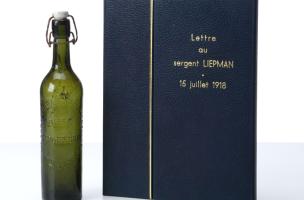
Lettre au sergent Liepman, après restauration.
© D. Gliksman, Inrap
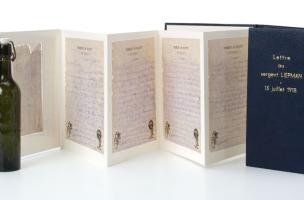
Lettre au sergent Liepman, après restauration.
© D. Gliksman, Inrap
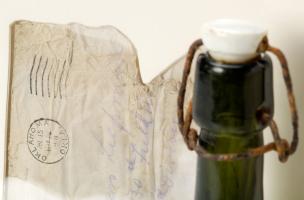
Lettre au sergent Liepman, après restauration (détail)
© D. Gliksman, Inrap
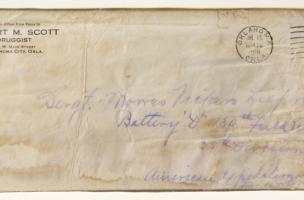
L'enveloppe avec le cachet de la poste d'Oklahoma city.
© D. Gliksman, Inrap
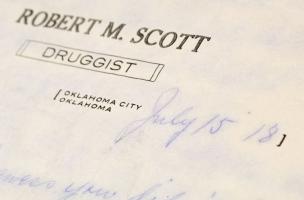
Entête de Robert M. Scott, drugist à Oklahoma city. Lettre au sergent Liepman.
© D. Gliksman, Inrap
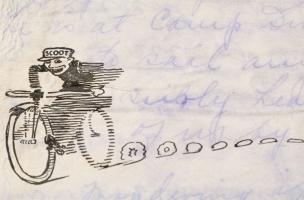
Détail du papier à lettre.
© D. Gliksman, Inrap
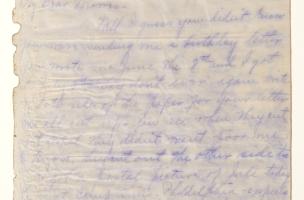
Un des 4 feuillets de la lettre au sergent Liepman.
© D. Gliksman, Inrap

Un des 4 feuillets de la lettre au sergent Liepman.
© D. Gliksman, Inrap
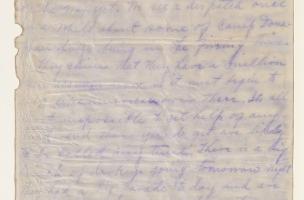
Un des 4 feuillets de la lettre au sergent Liepman.
© D. Gliksman, Inrap
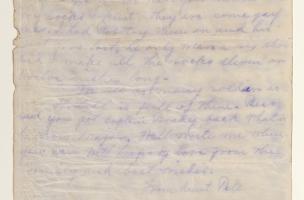
Un des 4 feuillets de la lettre au sergent Liepman.
© D. Gliksman, Inrap
Developers : OPAC of Merthe-et-Moselle and SOLEREM
Site directors : Marilyne Prévot, Inrap et Marc Leroy, cnrs, umr 5060
Curation : Regional Archaeology Service (DRAC Lorraine)
Restoration and presentation of the documents : The graphic document, binding and gilding restoration workshop of the conservation department of the Archives Nationales
Restoration of the bottle : Laboratory of the archaeology of metals of Nancy-Jarville
Contact(s) :
Mahaut Tyrrell
Media communication
Inrap, media partnerships and relations department
+33 (0)1 40 08 80 24
mahaut.tyrrell [at] inrap.fr


